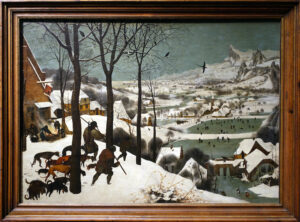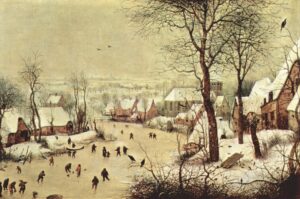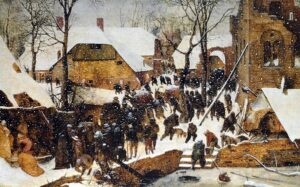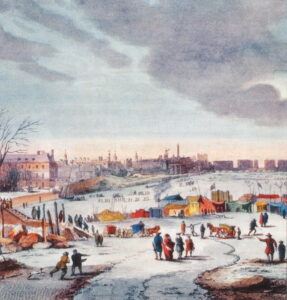Today, December 21, marks the Winter Solstice, the first day of winter. To celebrate, we are examining how the season was depicted in landscape paintings during the 16th Century.

Hunters in the Snow
Winter was a frequent subject for Flemish painter Pieter Bruegel the Elder. His extraordinarily detailed paintings use winter as a symbol for the passage of time. For instance, Hunters in the Snow (1565) perfectly depicts a wintertime village, complete with ice skaters in the distance, swooping birds, and minutely rendered bare tree branches. Winter Landscape with Skaters and Bird Trap, painted during the same year, is unique for its rendering of winter light in gradations of white, ivory, and yellow. Bruegel’s work is notable for its realism at a time when many artists preferred to depict idealized versions of nature. However, Hunters in the Snow is not entirely accurate; Bruegel transposed elements from his travels to Italy (specifically the Alps) into the flat Dutch landscape.

Winter Landscape with Skaters and Bird Trap
Bruegel’s son, Pieter Bruegel the Younger, continued this tradition with Adoration of the Magi in the Snow. As is common with Flemish painting from this period, the main figures are located to the side and surrounded by a crowd, allowing the artist to create an expansive scene and set the narrative in a wider context. In the Adoration, donkeys laden with exotic gifts for the Christ child are led through a throng of villagers as snow falls. Bruegel the Elder had previously tackled the same subject in 1563, although the figures of the Holy Family in his version are indistinct when seen from a distance, obscured by a blizzard. The snow renders the villagers’ everyday tasks – chopping wood, carrying water, setting out to hunt – almost magical.

Bruegel the Younger, Adoration of the Magi in the Snow
These paintings are not only beautiful, but they also offer a glimpse into the daily life of people five centuries ago. During the period when the Bruegels were active, Europe was in the grip of what is known as the “Little Ice Age,” which caused particularly cold and harsh winters. Rivers froze solid enough to allow merchants to set up shop on the water semi-permanently. The Thames Frost Fairs in London are a notable example. The most famous frost fair, called The Blanket Fair, was held during the Great Winter of 1683-84. It included many activities for attendees of all ages, such as ice skating, horse and coach races, and puppet plays. King Charles II is said to have attended the fair and enjoyed a bite of spit-roasted ox.
However, the extreme temperatures also led to food shortages, flooding, and may even have spurred the witch hunts. Ultimately, thousands of people died from illness and frostbite.
Although these paintings depict nature at its harshest, they can be uplifting as well. The winter landscapes allowed the Bruegels to experiment with composition and color, while breathing new life into the subject. Their virtuosity led to winter landscapes becoming embraced as a new and popular genre for patrons and artists while creating works that thousands of art lovers enjoy to this day.

Thomas Wyke, Thames Frost Fair
We hope you have enjoyed this tour through winters past. As the new year approaches, Amineddoleh & Associates wishes you all a prosperous 2021 and best wishes for this winter.